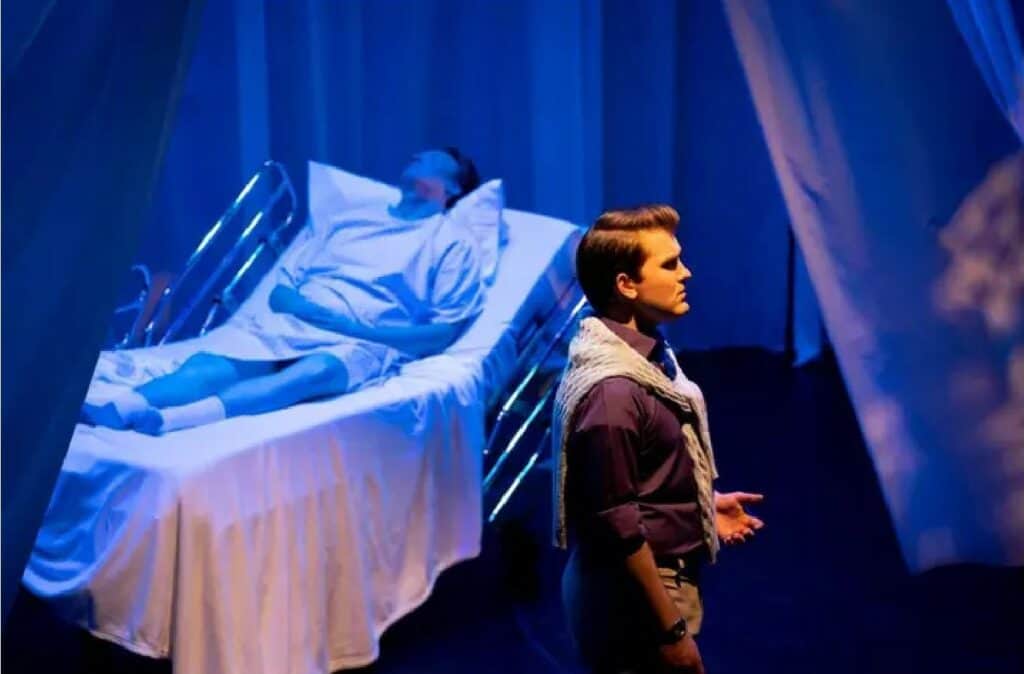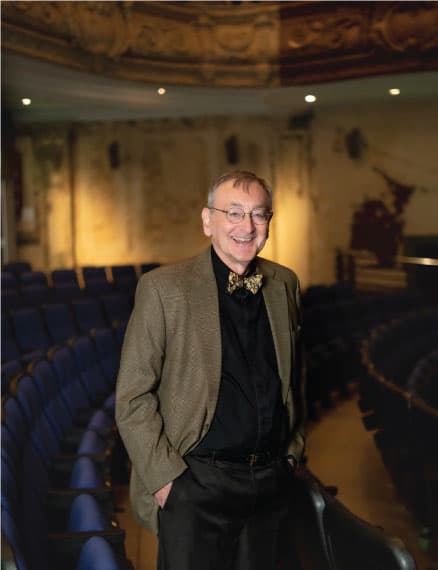The Songs May Not Stick, But the Happiness Will in Iron Crow’s Production of A NEW BRAIN

Posted on BroadwayWorld.com June 3, 2019
I’ve seen William Finn‘s A New Brain before – just on the screen and with a different ending, and then it was called All That Jazz. Okay, that’s not entirely fair, but I kept thinking how the basic idea and treatment was the same: each heavily autobiographical piece recounts, through song and dance, the creator’s brush with a potentially fatal condition. Each lays heavy emphasis on the regrets of the creator, after the onset of the medical crisis, for both the life he’s led and all the showbiz he didn’t get to create and may never get to create. It’s a powerful theme, well-conveyed in the new Iron Crow Theatre revival of A New Brain (which first appeared at the Mitzi Newhouse Theatre in Lincoln Center in 1998).
And of course there are differences. Bob Fosse, the creator of All That Jazz, was flagrantly and promiscuously heterosexual, and his primary medium was dance, and his movie ends with his imagined death. William Finn, the creator of A New Brain, is gay, and, at least as depicted in the show, happily monogamous, his primary medium is song, and his musical ends differently. It gives little away to say that A New Brain, as the title suggests, reaches a happy ending. But there is the same tough, cynical, and showbiz-centric outlook underlying both pieces.
William Finn is best known for the Falsettos musicals, but this is likely to be the audience’s first encounter with A New Brain (it was mine). It’s an odd piece, not only dramatically but musically, a sung-through musical which often swings harmonically for fences the ear does not anticipate, with varied results in terms of singability. One could sense the cast members still getting comfortable with some of the notes they had to land phrases on, particularly in solo moments. When they were comfortable, especially in the ensemble choral parts, they were often stunning to hear. Likewise, all of the big solo numbers were expertly fielded. For instance, Sebastian Ryder, as the hero’s mother, has a great number, “Throw It Out,” dedicated to forcibly deaccessioning her son’s books; Kathryne Daniels, as Rhoda, the hero’s best friend, delivers nicely a bit of an indecent patter number, “Whenever I Dream,” about the elusive meaning of dreams; and Brian Ott, as Roger, the hero’s significant other, gets a charming soft song about sailing (a pursuit resignedly deprecated as “goyish” by his Jewish lover). Nor can I fail to mention Danielle Harrow’s hilarious turn as a homeless woman hawking the very books the mom deaccessioned, in “The Homeless Lady’s Revenge.” Pretty much every cast member receives a showoff solo number, and each one is nailed. Hats off, therefore, to the other performers: Eva Hellerbach, John Knapp, and Nicholas Miles, each of whom could be similarly singled-out.
The hero himself, William Finn‘s alter ego, named Gordon Schwinn, is ably presented by Charles Johnson, who has to be a triple threat, singing and playing the piano (although Johnson gets a lot of unseen piano help from an offstage accompanist, either Suzanne Jones or Ching-Yi Lin), and serving as music director. (Johnson and Ott are pictured above.) The role, that of a man who effectively dies and comes back to life in what amounts to a resurrection narrative, has to be painted with a wide emotional palette, and Johnson, perhaps because he has been directed to, shows some colors more than others; I thought sometimes his expression was blank where the audience was looking to him to convey something more. But this is a comparatively minor complaint of a performer who has to subsist for nearly two acts in a hospital gown and spend much of that time on a gurney, and most of the rest in front of a piano.
I’ve mentioned a lot of the songs, but there are a lot of songs, over thirty by any count, to mention. And that forces a critic to bring up the strange thing about this lyrical cornucopia: almost nothing is hummable or catchy. It all works in context, but doesn’t stick in the mind much as one departs. (This is a frequent weakness in sung-through musicals.) There is a deliberate effort to craft just such a song, “I Feel So Much Spring,” as the closer, and it feels and sounds good, but by the time the song finishes, there have been so many harmonic variations sung by the various characters that the core melody has largely been overwritten mentally.
What will not be overwritten is the joyous feeling that the song, and the ending, bring about. Finn’s show – I should mention that the “book” as opposed to the lyrics, is credited to both Finn and James Lapine (though what constitutes a “book” in a sung-through musical is anyone’s guess) – will not send you out humming, but it will indeed send you out happy.
It may also be worth mentioning what this show represents in terms of Iron Crow’s own development. Iron Crow (which describes itself as Baltimore’s queer theater company) has recently gone through some well-publicized controversy. Whatever one may think of that, it seems clear from the large and enthusiastic contingent of theatergoers on opening night that Iron Crow’s audience stands behind it. And Iron Crow is not merely surviving; the program notes that Actors’ Equity members have been part of every show it has presented this season, and that the company is “laying the foundation for becoming Baltimore’s next Equity theatre.” It would be very exciting to have another Equity house join Center Stage, Everyman, and The REP. With a critical mass, it would be much easier to develop a pool of Equity-credentialed talent in this theater-intensive town. Fingers crossed.
Copyright (c) Jack L. B. Gohn except for production photo.
Photo credit: Rob Clatterbuck

 I lived in London and Vienna before coming to the United States, and grew up mainly in Ann Arbor. I was writing plays and stories as early as grade school. My undergraduate years at the University of Pennsylvania, where I first reviewed theater, for the college paper, were succeeded by graduate study at the Johns Hopkins University, where I earned a doctorate in English Literature.
I lived in London and Vienna before coming to the United States, and grew up mainly in Ann Arbor. I was writing plays and stories as early as grade school. My undergraduate years at the University of Pennsylvania, where I first reviewed theater, for the college paper, were succeeded by graduate study at the Johns Hopkins University, where I earned a doctorate in English Literature.